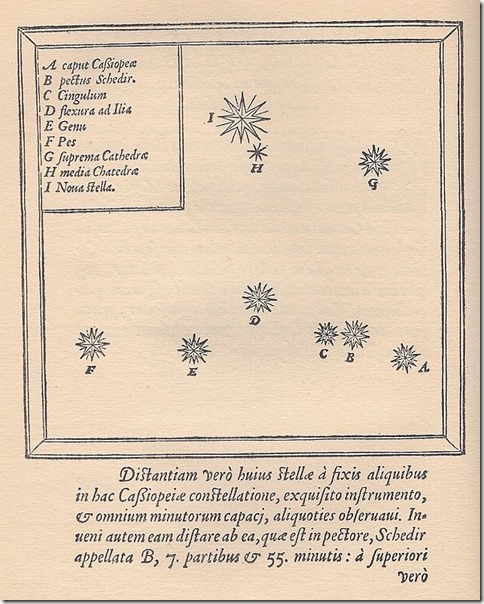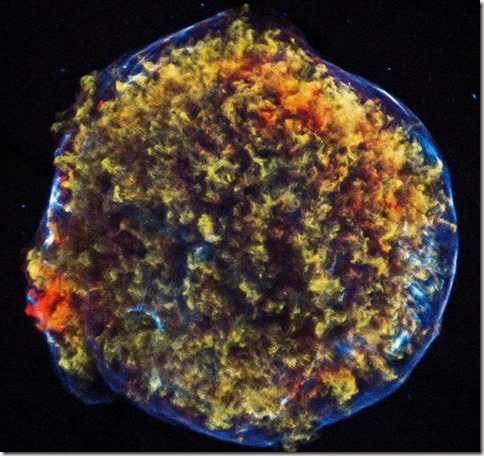by George Taniwaki
NASA recently celebrated the fifteenth anniversary of the launching of the Chandra X-ray Observatory by releasing several new images. One of the images, shown below, is an amazing composite that reveals in exquisite detail the turbulence surrounding the remnants of the Tycho supernova. (Scroll down to Figure 2, then come back.)
Tycho supernova
The scientific name of the Tycho supernova remnant is SN 1572, where SN means supernova and 1572 refers to the year it was first observed. That’s right, over 400 years ago, in November 1572, many people noticed a new bright object in the sky near the constellation Cassiopeia. Reports at the time indicated that it was as bright as Venus (peak magnitude of –4) meaning it was visible during the day.
SN 1572 is called the Tycho supernova because a Danish scientist named Tycho Brahe published a paper detailing his observations. His paper is considered one of the most important in the history of astronomy and science in the Renaissance.
Figure 1. Star map drawn by Tycho Brahe showing position of SN 1572 (labelled I) within the constellation Cassiopeia. Image from Wikipedia
What people at the time didn’t know was that SN 1572 was about 9,000 light years away, meaning it was unimaginably far away. The explosion that caused it happened long ago but the light had just reached the earth.
(Actually, SN 1572 is fairly close to us relative to the size of the Milky Way which is 100,000 light years across, and extremely close relative to the size of the observable universe which is 29 billion light years across. Space is just really unimaginably large.)
What they also didn’t know was that SN 1572 was probably a Type 1a supernova. This type of supernova is common, and has a very specific cause. It starts with a binary star system. Two stars orbit one another very closely. Over time, one of the stars consumes all of its hydrogen and dies out, leaving a carbon-oxygen core. Its gravity causes it to accrete the gas surrounding it until its mass reaches what is called the Chandrasekhar limit and it collapses. The increased pressure causes carbon fusion to start. This results in a runaway reaction, causing the star to explode.
About a supernova remnant
In the 400 years since SN1572 exploded, the debris from it has been flying away at 5,000 km/s (3100 mi/s). It is hard to see this debris. Imagine a large explosion on the earth that occurs at night.
The debris itself doesn’t generate very much light, but it does produce some. Space is not a vacuum. It is a very thin gas. When electrons from the moving debris of the supernova remnant strike a stationary particle, it gives off a photon (which depending on the energy of the collision, is seen as radio waves, microwaves, visible light, UV, or x-rays). This energy also heats up the remaining particles, releasing additional photons, making them detectable with a very sensitive telescope.
About false color images
The Chandra X-ray Observatory was launched in 1999 from the space shuttle Columbia. As the name implies, it can take digital images of objects in the x-ray range of light. Since humans cannot see in this range, images taken in the x-ray range are often color coded in the range from green to blue to purple.
Often, composite images of space objects are created using telescopes designed to capture photons from different wavelengths. For instance, visible light telescopes like the Hubble Space Telescope often have the colors in their images compressed to black and white. Images from infrared telescopes, like the Spitzer Space Telescope, and ground-based radio telescopes are often given a false color range between red to orange.
Pictures please
All right, finally the results. Below is the most detailed image ever of the Tycho supernova remnant. It is a composite created by layering multiple, long-exposure, high-resolution images from the Chandra X-ray Observatory. The press release says, “The outer shock has produced a rapidly moving shell of extremely high-energy electrons (blue), and the reverse shock has heated the expanding debris to millions of degrees (red and green).
“This composite image of the Tycho supernova remnant combines X-ray and infrared observations obtained with NASA’s Chandra X-ray Observatory and Spitzer Space Telescope, respectively, and the Calar Alto observatory, Spain.
“The explosion has left a blazing hot cloud of expanding debris (green and yellow) visible in X-rays. The location of ultra-energetic electrons in the blast’s outer shock wave can also be seen in X-rays (the circular blue line). Newly synthesized dust in the ejected material and heated pre-existing dust from the area around the supernova radiate at infrared wavelengths of 24 microns (red).”
Figure 2. Tycho supernova remnant composite image released in 2014. Image from NASA
Compare Figure 2 above to an image of the Tycho supernova remnant that NASA released in 2009 using data from observations made in 2003 shown below. Notice the lack of details. Also notice the large number of stars in the background, some even shining through the dust of the explosion. Apparently, the image above has been modified to eliminate most of these distractions.
These two images dated only a few years apart reveal what is likely remarkable advances in software for manipulating space images. I say that because the hardware in the telescopes themselves, such as optics, detectors, and transmitters probably have not changed much since launch. Thus, any improvements in resolution and contrast between the two images is a result of better capabilities of the software used to process images after the raw data is collected.
Figure 3. Tycho supernova remnant composite image release in 2009. Image from NASA



Leave a comment